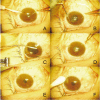Neodymium YAG laser and surgical synechiolysis of iridocapsular adhesions
- PMID: 18784442
- PMCID: PMC2629902
- DOI: 10.3341/kjo.2008.22.3.159
Neodymium YAG laser and surgical synechiolysis of iridocapsular adhesions
Abstract
Purpose: Several articles have been published on the successful elimination of iridolenticular synechiae after cataract extraction with a neodymium YAG laser (Nd:YAG laser) and surgical synechiolysis during cataract surgery, but the indications recommending which method is proper to use for specific kinds of adhesions have not yet been established.
Methods: We retrospectively reviewed the medical records of 106 patients who had undergone Nd:YAG laser or surgical synechiolysis between January 2002 and December 2007 in our clinic. Laser synechiolysis was performed in the synechiae not exceeding the extent of one clock hour and reaching only to the iris sphincter, whereas surgical synechiolysis was performed in other diffuse and/or thick synechiae.
Results: Surgical synechiolysis was performed in 93 eyes, and YAG laser synechiolysis was done in 21 eyes. Increases in best-corrected visual acuity (BCVA) were observed in 61 eyes (53.51%). Intraocular pressure spikes after the procedure were present in only 4 eyes, and all of them were transient except for 1 eye, which needed additional glaucoma eyedrops.
Conclusions: With suitable indications, laser or surgical synechiolysis can be performed safely, and a small rise in visual acuity may also be expected.
Figures


Similar articles
-
Neodymium: YAG laser iridolenticular synechiolysis in uveitis.Ophthalmic Surg. 1994 May;25(5):288-91. Ophthalmic Surg. 1994. PMID: 8058259
-
Incidence, causes, and neodymium:YAG laser treatment of pupillary capture.J Cataract Refract Surg. 1997 Nov;23(9):1404-8. doi: 10.1016/s0886-3350(97)80123-x. J Cataract Refract Surg. 1997. PMID: 9423916
-
Long-term follow-up of neodymium:YAG laser anterior capsulotomy for the treatment of anterior capsular phimosis.J Int Med Res. 2018 Sep;46(9):3692-3697. doi: 10.1177/0300060518777652. Epub 2018 Jun 19. J Int Med Res. 2018. PMID: 29916304 Free PMC article.
-
YAG anterior capsulectomy and lysis of posterior synechiae after cataract surgery.Ophthalmic Surg. 1992 Feb;23(2):103-7. Ophthalmic Surg. 1992. PMID: 1549284
-
YAG lasers in cataract surgery.Int Ophthalmol Clin. 1987 Fall;27(3):181-94. doi: 10.1097/00004397-198702730-00007. Int Ophthalmol Clin. 1987. PMID: 3308748 Review. No abstract available.
Cited by
-
Occlusio Pupillae: A Duet of Darkness Where the Patient Sees Naught, and the Doctor Discerns Not.Cureus. 2024 Jun 28;16(6):e63370. doi: 10.7759/cureus.63370. eCollection 2024 Jun. Cureus. 2024. PMID: 39070462 Free PMC article.
-
Microperipheral Iridectomy for Troublesome Posterior Synechiolysis in Secondary Intraocular Lens Implantation.J Ophthalmol. 2021 Feb 23;2021:6634871. doi: 10.1155/2021/6634871. eCollection 2021. J Ophthalmol. 2021. PMID: 33680507 Free PMC article.
References
-
- Kim TG, Yoo JS, Kim MH, Huh W. Clinical effect of Nd-YAG synechiolysis. J Korean Ophthalmol Soc. 1999;40:127–132.
-
- Fankhauser F, Kwasniewska S, Klapper RM. Neodymium Q-switched YAG laser lysis of iris lens synechiae. Ophthalmology. 1985;92:790–792. - PubMed
-
- Kumar H, Ahuja S, Garg SP. Neodymium: YAG laser iridolenticular synechiolysis in uveitis. Ophthalmic Surg. 1994;25:288–291. - PubMed
-
- Ganesh SK, Padmaja, Babu K, Biswas J. Cataract surgery in patients with Vogt-Koyanagi-Harada syndrome. J Cataract Refract Surg. 2004;30:95–100. - PubMed
MeSH terms
LinkOut - more resources
Full Text Sources
Medical

